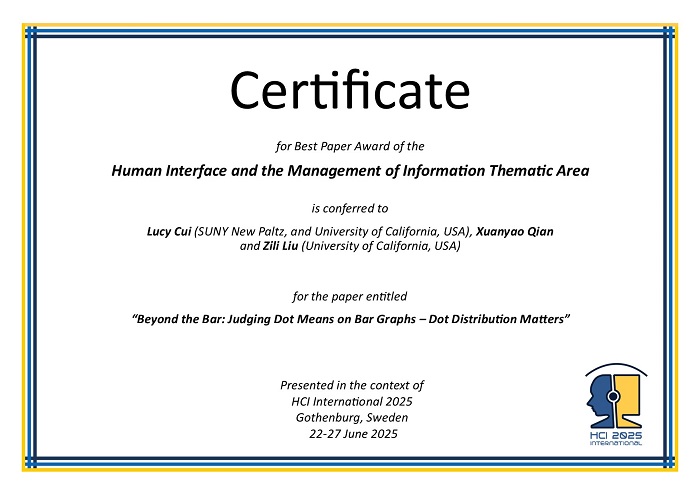The Best Paper Award of the Human Interface and the Management of Information Thematic Area
has been conferred to
Lucy Cui (SUNY New Paltz, and University of California, USA), Xuanyao Qian and Zili Liu (University of California, USA)
for the paper entitled
"Beyond the Bar: Judging Dot Means on Bar Graphs – Dot Distribution Matters"

Lucy Cui
(presenter)

Best Paper Award for the Human Interface and the Management of Information Thematic Area, in the context of HCI International 2025, Gothenburg, Sweden, 22 - 27 June 2025

Certificate for Best Paper Award of the Human Interface and the Management of Information Thematic Area presented in the context of HCI International 2025, Gothenburg, Sweden, 22 - 27 June 2025
Paper Abstract
Bar plots have always been commonly used in academia to show the means of conditions/groups. However, there are some concerns with bar plots, such as misconceptions and misinterpretations . One concern is the within-bar-bias, or people’s tendency to believe dots within the bar contribute to the bar edge more than dots outside the bar. This alongside other concerns have motivated people to show their data superimposed on bar plots or other plots. In this study, we investigate whether people have a within-bar-bias when viewing data points superimposed over a bar plot. We have participants view plots where we have manipulated the bar and data features (e.g., bar vs. line/control, filled vs. unfilled bar, same-color vs. different-color data) and judge whether the dot mean is above or below the bar edge. Participants completed the trials in random order. We did not find a within-bar-bias. However, we did find people’s performance on this task depended on the dot distribution, i.e., percentage of dots within the bar. They were more biased to respond that the dot mean is below the bar edge when there were more dots within the bar.
The full paper is available through SpringerLink, provided that you have proper access rights.


